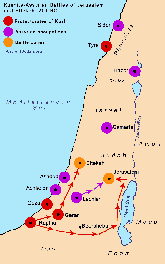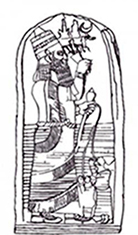HistoryThe Kushite Conquest of Palestine and the
|
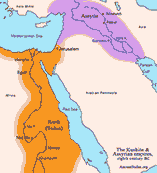 |
Evidence suggest that the Kush maintained a protectorate relationship over Lebanon. In exchange for political and economic subordination, the Phoenician kings were promised protection privilages by the pharaohs of Kush. A prayer text belonging to pharaoh Taharqa indicates that Kush has recieved a regular tribute from the Levant.2 Archeological finds shows that materials from the Levant, particularily Lebanon, were regularly imported to Sudan during this period of Kushite history.3
About the same time, the subordinate Egyptian bureaucracy rebelled against the Kushite rule. Pharaoh Shabako deployed a large military force from homeland Sudan to put down the rebels in Lower Egypt. The Kushite military hunted down the rebels and established Memphis as the official capital of Kushite Egypt. In 706 BC, Shabako made his son, Shebiktu, the second in command after the pharaoh and the overseer and regulator of colonized Egypt.
Shebiktu, the Pharaoh of Kush, maintained a peaceful policy with Sargon of Assyria who, at the time, was expanding his Assyrian empire in the Near East. In 704 BC, Sargon died in Tubal. His death brought hopes of independence to the Near Eastern districts that fell under his imperial control. Shabako the Kushite pharaoh took advantage of this situation and supported the anti-Assyrian rebels in the Near East, including those in Syria and Phoenicia.
A victory stele, dating to the seventh century BC, shows the assyrian king Esarhaddonn holding the later pharaoh of Kush Taharqa and Abdi Milkuti (of Sidon) in bondage,4 which further testifies to the relationship between the Phoenician cities and Kush. Accordingly,
One year later (705 BC), Sennacherib succeeded Sargon to the Assyrian throne. He destroyed all the rebellions, starting with those in his homeland in Mesopotamia, including the Babylonian and the Chaldean rebellions, and marched west to re-conquer the territory lost after Sangon’s death. In 702 BC, Shebiktu succeeded his father as the king of Kush. Following in his father’s steps, Shabikto continued to support the anti-Assyrian movements.
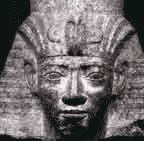
|
By 701 BC, Sennacherib was advancing with his military from the Syrian Desert west towards the Phoenician cities of Sidon annd Tyre. Although Sidon may have surrendered as the Assyrian accounts invoke, Tyre was certainly not subdued. Since the Phoenician kings were already in a protoctorate relationship with Kush, the success of Tyre in repulsing the Assyrians is most likely due to military support from Kush. The military of a city as small as Tyre could not have solely repulsed the powerful Assyrians.
The Assyrian troops continued to move down the coast chasing the Philistine rebels, including those lead by King Sidqi of Ashkelon; the latter king failed to receive military support from Kush . The Assyrian armies, thereafter, infiltrated into Philistia and into the mainland of Judea. Then, they besieged and subdued the major cities of Judean kingdom, except for Jerusalem. The southern region of Philistia and southwestern areas of Judea—like Raphia, Gaza, and Gerar—5 were under the protection of Kush and were not subjected to Assyrian rule.
According to the Bible, King Hezekia, who was ruling Jerusalem at the time, refused to surrender Jerusalem to the Assyrian King as Prophet Isaiah has instructed him. Hezekiah ordered his men to cut off the Gihon spring, the only source of water outside the city walls; this way, when the Assyrians reached Jerusalem (see 2 Chronicles 32: 1-5), they found no water.
|
|
Taharqa's minor military force, on the other hand, moved towards the city of Jerusalem. Being dispersed and thirsty, the Assyrian besiegers were an easy prey for the Kushites. The Kushites probably made their attack from the mountains east of Jerusalem, an excellent location to shower their arrows on the enemy. According to the Bible, as the Jerusalemites "arose in the morning, behold, they (Assyrian besiegers) were all dead corpses" (Isaiah 37: 36). The Assyrian besiegers seem to have experienced a surprise attack by Kush's light infantry troops. The Kushites were well known in the ancient world for the latter strategy.
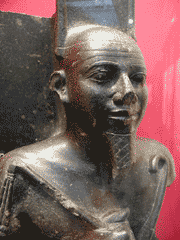
|
The Eltekeh battle ended by the defeat of the Assyrians. Although Eltekeh and Jerusalem appear to have been the major battle sites between the Assyrians and the Kushite, archeological evidence suggests that conflicts took place elsewhere in Judea. Beersheba, Beth-Shemesh, Ramet Rahel, and Gezer all showed evidence of destruction activities dating to the period.
Following his defeat, Sennacherib, king of Assyria, withdrew to his homeland though still continued to control Syria . There in Ninveh, the capital of Assyria , Sennacherib was assassinated by his two sons, Adrammelech and Sharezer. The two sons then fled leaving Esarshaddon as the only heir to the throne.
When Sennacherib withdrew the pharoahs of Kush reasserted their control over the Levant. The period between 683 and 681 BC, the Kushite state reasserted its control over the Levant, particularly Lebanon.6
In 679 BC,Esarhaddon occupied Judea. In 674 BC, after spending five years in subduing Phoenicia , Esarshaddon marched with a massive military force and penetrated into the Egyptian border. There, Taharqa, already crowned king of Kush after the death of Shebikto, fought a bloody battle against Esarhaddon and inflicted a heavy defeat on him.
Three years later, in 671 BC, Esarshaddon left a stele in Phoenicia where he prays to the sun god Shamash to support him in his upcoming campaign to retake Palestine from the Kushite forces.7 This makes it clear that after Esarshaddon's defeat in Egypt, Taharqa's Kushite troops had already re-occupied Palestine, and, up to this period, Kush was the dominant power in Palestine.
In the same year, Esarshaddon invaded Egypt again. However, this time he was successful in driving out the Kushites as far south as the outskirts of Memphis where Taharqa resided. There, Esarhaddon ravaged the city and captured Taharqa's strong hold along with his wife and son. Luckily, Taharqa managed to escape the slaughter.
The Assyrians continued to destroy whatever they could find that is related to the Kushite royalty. Therefore, no significant Kushite accounts have survived the Assyrian devastation in Egypt. Such accounts would have been greatly valuable in enriching our knowledge of the circumstances of the period. Subsequently, the Kushites held to their Egyptian territories south of Memphis while the fight with the Assyrians ensued from time to time.
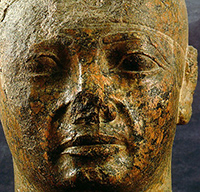 |
Seven years later, in 664 BC, Taharqa died; he was in his fifties. His nephew, Tanwetamani, inherited the throne. It is inscribed on a stele at Jebel Barkal that Tanwetamani, at the very beginning of his reign, dreamt of two snakes. One snake represented the crown of Kush and the other of Egypt. The pharaoh interpreted the dream as a sign of devine permission to wage war and re-occupy Egypt, which his uncle had lost to the Assyrians. Herodotus confirms Tanwetamani's dream account and states that the pharaoh had departed to Egypt in consequence of "the vision of the dream"(Herodotus ii. 152).8 Whether those dreams were used as propaganda to gain public support, or as a religious obligation, they obviously influenced the decision-making process.
In that same year, Tanwetamani invaded and captured all of Egypt. However, this Kushite return did not last more than two years. On the Assyrian throne, Ashurbanipal succeeded Esarhaddon and returned with a military to re-take Egypt. Twanwetamani was thus forced to withdraw from Lower Egypt and retreated to Thebes. Shortly, Tanwetamani also had to withdraw from Thebes to the Assyrians and retreated farther south. However, all the area south of Thebes continued to be Kushite territory.
The New Egyptian Dynasty and Kush:
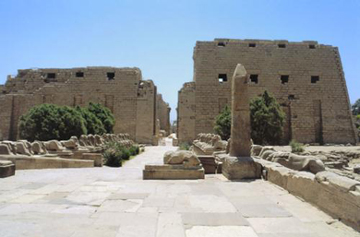
|
In 654 BC, the Egyptian Psammetik I liberated both Lower and Upper Egypt from the Assyrians and regained Thebes. He further expelled the Kushite officials who ran the Cult of Amon there, and appointed his daughter as the high priestess of Amon.
The 26th Dynasty of Egypt exhibited a lot of animosity towards Kush. Psammetic, ruler of the 26th Dynasty, had his father executed by Kushite Pharaoh Shabako. In fear of his own life, Psammetic escaped to Syria as a "fugitive"(Herodotus ii. 152) and did not return until 654 BC. Psammetic and later his sons of the 26th Dynasty were vengeful towards Kush. They erased almost every inscription, records, or artefact that belonged to the earlier era of Kushite rule. They carried a series of unsuccessful military campaigns to invade Kush.
In 593 BC Psammetic II, successor of Psammetic I, marched with a huge army towards Kush. Egyptian inscriptions claim that the Egyptians have inflicted a defeat on the Kushites at one battle north of Napata. The claim is probably not true since there is no physical evidence for Egyptian military invasion there.
During this period, the region of Lower Nubia became the no-man's land between Egypt and Kush . Thus, the population of Lower Nubia greatly intermixed with the Egyptians, the Kushites, as well as with other foreign settlers. The Jews, for example, formed large community at Elephantine.9
- 1 R. Kletter, Economic Keystones: The Weight System of the Kingdom of Judah (Sheffield Academic P, 1998), S. Dalley, "Recent Evidence from Assyrian Sources for Judaean History from Uzziah to Manasseh", Journal for the Study of the Old Testament, Vol. 28, No.4, (2004): 387-401, and H. T. Aubin, The Rescue of Jerusalem: The Alliance of Hebrews and Africans in 701 B.C. (Soho P, 2002) 155-6.
- 2 D. Kahn, "Taharqa, King of Kush and the Assyrians" JSSEA 31 (2004) 109-128, 111 <http://jan.ucc.nau.edu/gdc/ssea/vol31/kahn%20article.pdf>.
- 3 Kahn, see note 2 above at 110.
- 4 G. Maspero, History of Egypt, Chaldea, Syria, Babylonia, and Assyria, ed. A. H. Sayce, trans. M. L. McClure, Vol. VIII. (London: The Grolier Society).
- 5 See: B. E. Kelle, Essential Histories: Ancient Israel at War 853-586 BC (Oxford: Osprey P) 50.
- 6 Kahn, see note 3 above.
- 7 For a comprehensive account of the Nubian invasion of Palestine see: H. T. Aubin, The Rescue of Jerusalem: The Alliance of Hebrews and Africans in 701 B.C. (Soho P, 2002).
- 8 Herodotus, and D. Lateiner, The Histories, trans. G. C. Macaulay (Barnes & Noble Classics, 2004).
- 9 See: Investigating the Origin of the Ancient Jewish Community at Elephantine: A Review (click here for link).
Edited: Jan. 2009.
